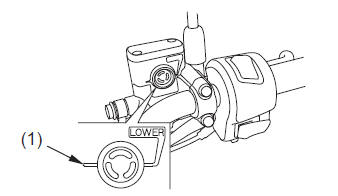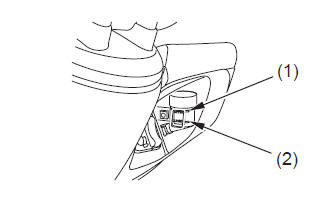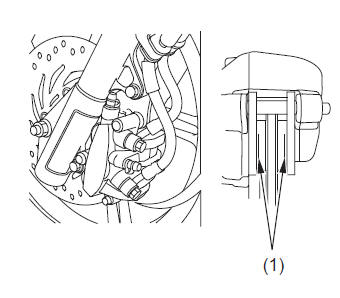 Honda PCX125 - Owner's Manual > Chassis
Honda PCX125 - Owner's Manual > Chassis
Brakes
The hydraulic (front) and mechanically-activated drum (rear) braking systems on your scooter dissipate the heat generated by the friction of the brake pads on the disc (front) and the brake shoes on the drum (rear) as the wheels are slowed.
Hydraulic Front Brake
As the brake pads wear, the brake fluid levels in both reservoirs will drop. A leak in the system will also cause the level to drop.
Frequently inspect the system to ensure there are no fluid leaks. Periodically inspect the brake fluid levels in both reservoirs and the brake pads for wear.
If the brake lever freeplay does not feel within the normal range while riding, check the brake pads for wear.
Worn pads should be replaced. If the pads are not worn beyond the recommended limit, there is probably air in the brake system. See your Honda dealer to have the air bled from the system.
Brake Fluid Recommendation

The recommended brake fluid is Honda DOT 3 or DOT 4 Brake Fluid, or any brake fluid of equal quality and performance. Use fresh brake fluid from a sealed container. Be sure to read the label before opening the sealed container. An opened container may be contaminated or may have absorbed moisture from the air.
Fluid Level Inspection
If your inspection indicates a low fluid level, have your Honda dealer add the recommended brake fluid.
Do not add or replace brake fluid, except in an emergency. If you do add fluid, have your Honda dealer check the system as soon as possible.

Brake fluid can damage plastic and painted surf aces. Handle with care.
Wipe up spills immediately. Avoid brake fluid contact with skin or eyes. If it comes in contact with your eyes, wash them out with clean water and immediately call a doctor. If it comes in contact with your skin, wash with clean water and, if necessary, call a doctor.
RIGHT HANDLEBAR

- LOWER level mark
Front Brake Fluid Level
1. Place your scooter in an upright position on a firm, level surface.
2. Check the fluid level.
It should be above the LOWER level mark (1).
If the level is at or below the LOWER level mark, check the brake pads for wear.
Worn pads should be replaced. If the pads are not worn beyond the recommended limit, have your brake system inspected for leaks.
Other Inspections
- Make sure there are no fluid leaks.
- Check for deterioration or cracks in the hoses and fittings.
CBS Brake Fluid Level
1. Place your scooter in an upright position on a firm, level surface.
2. Check the fluid level. It should be between the UPPER (1) and LOWER (2) level marks. If the level is at or below the LOWER level mark, check the brake pads for wear.
Worn pads should be replaced. If the pads are not worn beyond the recommended limit, have your brake system inspected for leaks.
Other Inspections
- Make sure there are no fluid leaks.
- Check for deterioration or cracks in the hoses and fittings.
BESIDE IGNITION SWITCH

- UPPER level mark
- LOWER level mark
Brake Pad Wear
Brake pad wear depends upon the severity of usage, the type of riding, and road conditions. Generally, the pads will wear faster on wet and dirty roads. Inspect the pads at each regular maintenance interval.
Check the wear indicator mark (1) in each pad. If either pad is worn to the wear indicator mark, replace both pads as a set.
See your Honda dealer for this service.
LEFT FRONT

- wear indicator marks
Rear Brake Lever Freeplay
LEFT HANDLEBAR

- rear brake lever
Adjust the freeplay of the rear brake lever with the front wheel pointed straight ahead.
Inspection
1. Place your scooter on its center stand.
2. Check freeplay by pulling in slowly on the rear brake lever (1) until the brake starts to engage.
Freeplay at the tip of the brake lever should be: 3/8-13/16 in (10-20mm)
If necessary, adjust to the specified range.
Adjustment
1. Adjust by turning the brake adjusting nut (2) a half-turn at a time. Make sure the cut-out on the adjusting nut is seated on the brake arm pin (3).
LEFT REAR

- adjusting nut (+) increase freeplay
- brake arm pin (-) decrease freeplay
2. Apply the brake, release it, and then spin the wheel and check that it rotates freely. Repeat this procedure several times.
3. Check the freeplay. If you can't adjust the freeplay properly, see your Honda dealer.
After adjustment, push the brake arm (4) to confirm that there is a gap between the rear brake adjusting nut (2) and the brake arm pin (3).

- adjusting nut
- brake arm pin
- brake arm
After adjustment, confirm the freeplay of the brake lever.

- adjusting nut
- brake arm pin
Other Inspections
- Make sure the brake arm, spring, and fasteners are in good condition.
Brake Shoe Wear
The rear brake is equipped with external brake wear indicators that let you check brake wear without disassembly.
Application of the brake control causes the arrow on the brake arm to move toward a reference mark on the brake panel.
LEFT REAR

- arrow
- brake arm
- reference mark
- brake panel
1. Place your scooter on its center stand.
2. Apply the brake and check the movement of the arrow (1) on the brake arm (2). Replace the brake shoes if the arrow aligns with the reference mark (3) on the brake panel (4) upon full application of the brake. If replacement is necessary, see your Honda dealer.
See also:
 Honda PCX125 - Owner's Manual > Engine
Honda PCX125 - Owner's Manual > Engine
Throttle Throttle Inspection 1. Check that the throttle assembly is positioned properly and the securing bolts are tight. 2. Check for smooth rotation of the throttle from fully open to fully closed in all steering positions. If there is a problem, see your Honda dealer.
 Honda PCX125 - Owner's Manual > Tires
Honda PCX125 - Owner's Manual > Tires
To safely operate your scooter, your tires must be the proper type and size, in good condition with adequate tread, and correctly inflated for the load you are carrying. Using tires that are excessively worn or improperly inflated can cause a crash in which you can be seriously hurt or killed.
 Rider's Manual BMW R 1250 GS GSA
Rider's Manual BMW R 1250 GS GSA Owner's Manual Harley-Davidson Sportster XL1200X Forty-Eight
Owner's Manual Harley-Davidson Sportster XL1200X Forty-Eight Owner's Manual Honda CBR650R
Owner's Manual Honda CBR650R Service manual Honda CBR650
Service manual Honda CBR650 Owner's Manual Honda PCX125
Owner's Manual Honda PCX125 Owner's Manual Kawasaki Z1000SX
Owner's Manual Kawasaki Z1000SX Service manual Kawasaki Z1000SX
Service manual Kawasaki Z1000SX Owner's Manual Lexmoto Echo
Owner's Manual Lexmoto Echo Owner's Manual Royal Enfield Interceptor 650
Owner's Manual Royal Enfield Interceptor 650 Service manual Royal Enfield Interceptor 650
Service manual Royal Enfield Interceptor 650 Owner's Manual Yamaha MT-07
Owner's Manual Yamaha MT-07